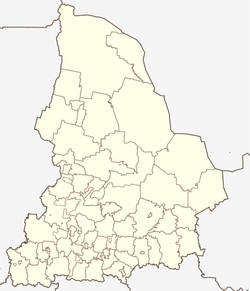Nizhny Tagil
| Nizhny Tagil (English) Нижний Тагил (Russian) |
|
|---|---|
| - City - | |
 Location of Sverdlovsk Oblast in Russia |
|
|
|
|
|
|
|
|
|
|
| Administrative status (as of 2011) | |
| Country | Russia |
| Federal subject | Sverdlovsk Oblast |
| Administratively subordinated to | City of Nizhny Tagil |
| Administrative center of | Prigorodny District, City of Nizhny Tagil |
| Municipal status (as of June 2009) | |
| Urban okrug | Nizhny Tagil Urban Okrug |
| Administrative center of | Nizhny Tagil Urban Okrug |
| Mayor | Sergey Nosov |
| Statistics | |
| Population (2010 Census) | 361,811 inhabitants |
| - Rank in 2010 | 48th |
| Time zone | YEKT (UTC+05:00) |
| Founded | October 1722 |
| City status since | 1919 |
| Dialing code(s) | +7 3435 |
|
|
|
| on | |
Nizhny Tagil (Russian: Нижний Тагил; IPA: [ˈnʲiʐnʲɪj tɐˈgʲil]) is a city in Sverdlovsk Oblast, Russia, located 25 kilometers (16 mi) east of the virtual border between Europe and Asia. Population: 361,811 (2010 Census);390,498 (2002 Census);439,521 (1989 Census).
Rivers and ponds take up one third of the city's territory. Nizhny Tagil spans 22 kilometers (14 mi) from north to south and 21 kilometers (13 mi) from east to west. The city is built around the extinct volcano Lisya Mountain. This mountain with a watchtower on its top is a symbol of the city. Another mountain, Medved-Kamen, is located in the northern part of the city and is 100 meters (330 ft) high. High rock walls break into the Tagil River.
Neighboring cities include Yekaterinburg 130 kilometers (81 mi) to the south, Serov and Priobye in the north, Perm in the west, and Alapayevsk and Verkhnyaya Salda in the east.
The city's climate is temperate continental.
The altitude of the city varies from 170 to 380 meters (560 to 1,250 ft). This makes Nizhny Tagil one of the rare natural store-rooms on the Earth. There are many mineral deposits containing 63 elements of the periodic table.
The history of Nizhny Tagil begins with the opening of the Vysokogorsky iron ore quarry in 1696. The deposits were particularly rich, and included lodes of pure magnetic iron. The surrounding landscape provided everything needed for a successful and productive mining and smelting operation — rivers for transport, forests for fuel, and suitable climate.
...
Wikipedia



